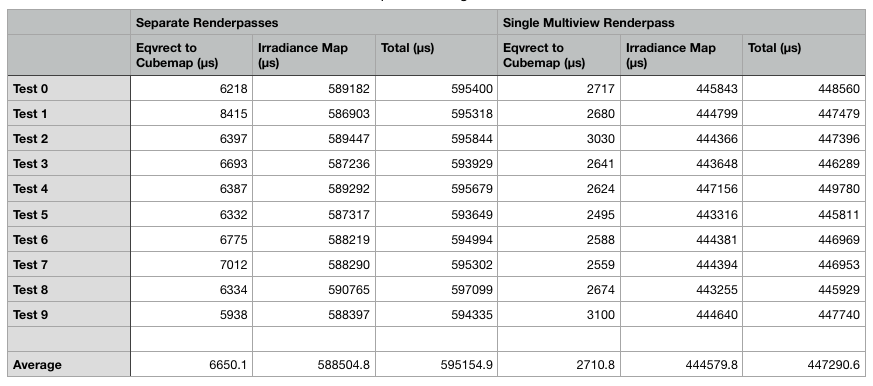Vulkan Render to Cubemap Using Multiview
While writing Blaze, and heavily referring Sascha Willem’s Vulkan Samples, I came across the part of writing to cubemaps (PBR-IBL calculations, Shadow Mapping etc) Sascha used a 2D framebuffer attachment to render to, and then copy to a face of the cubemap. But, back when I used learnopengl.com Joey de Vries used Geometry shader for Omni-directional Shadow Mapping. So I ended up researching alternatives - since I’ve read Geometry shaders are nasty business (they are slower in quite a few cases) and the one face at a time felt boring.
Alternatives⌗
- 2D framebuffer + copy to face (as in the samples)
- Geometry Shader (old wisdom from LearnOpenGL.com days)
- Multiview (What I ended up choosing)
Why not Geometry Shader?⌗
OpenGL allowed us to use Geometry Shader and gl_Layer to actually render to a face of the cubemap – therefore Vulkan should too. One search worth of digging later, I found an issue on the repo where case against Geometry shaders was made.
Whilst digging more resources on why so, I found this gem of an analysis by Joshua Barczak. It concludes that unless you’re using an Intel GPU, Geometry Shader would probably be slower (It is very workload and implementation dependent)
Now, while I could have tried and tested it (maybe sometime in the future?) I decided to just go with the MultiView approach instead – as it was something commented on the GS issue.
What is Multi-view?⌗
Initially an OpenGL OVR Extention, Multi View allows reducing draw calls by allowing multiple layers of a Framebuffer Attachment to be written to from a single draw call.
Of course, the aim of Multi View is to be used for multi-Viewport rendering (VR / Stereoscopic). But since multiview has no restrictions on number of layers on the attachment, we can just as well write to the Cubemap.
How to Multi-view?⌗
I’m using a 2D attachment RenderPass and Pipeline as the starting point.
1. Enabling the Extension⌗
Simply enable the VK_KHR_multiview (VK_KHR_MULTIVIEW_EXTENSION_NAME) extension while creating the Logical Device.
2. Creating a Multi-View RenderPass⌗
Creating a Multi-View RenderPass only requires a slight addition to the existing VkRenderPassCreateInfo.
The pNext field needs to be set to a VkRenderPassMultiviewCreateInfo
VkRenderPassMultiviewCreateInfo createInfo{};
createInfo.sType = VK_STRUCTURE_TYPE_RENDER_PASS_MULTIVIEW_CREATE_INFO;
createInfo.subpassCount = 1;
createInfo.pViewMasks = &viewMask;
createInfo.correlationMaskCount = 1;
createInfo.pCorrelationMasks = &correlationMask;
Quick Explanation:⌗
subpassCountis not only the number of subpasses in the render pass but also the number of view masks inpViewMasks- Each view mask is an unsigned int, where ith least significant bit denotes the layer number. 0b0011 means write to layer 0 and 1.
- For our cubemap, we will have only one subpass, writing to all the faces (viewMask = 0b00111111)
- According to the spec, correlation masks denote which views have high spatial coherence – since our cubemaps will be ideally facing 6 completely different directions – I think they should be left to null (I’ll update this if I’m wrong)
3 Attaching the Cubemap to the Framebuffer⌗
Ideally the simplest part – standard framebuffer, just set createInfo.layers = 6
4 Views Uniform Buffer⌗
For each face of the cubemap, you will need a View. This should be easy. Just create the 6 view matrices and put them on a uniform buffer.
5 Shaders⌗
The fragment shader does not change for this. The only difference is in the vertex shader. Instead of having one view matrix coming in, we would now index a view matrix from the uniform buffer using the gl_ViewIndex variable.
That’s it!⌗
With all these changes, instead of a simple 2D attachment, you can now attach a cubemap and get it running.
Perf?⌗
Performance comparison between separate passes vs multiview is in the graph below.

Consistently Multi-View outperforms having separate render passes. I would guess that the lack of copy operations and draw submits should save the time.